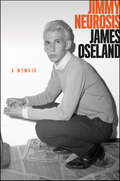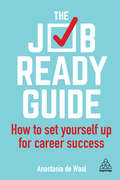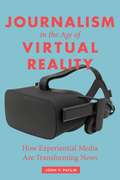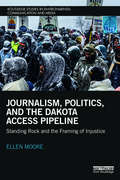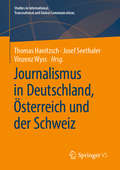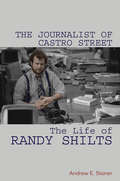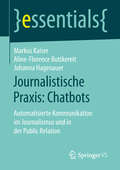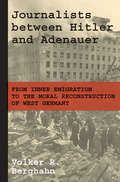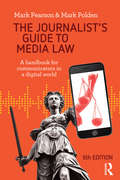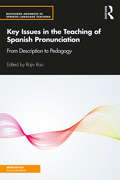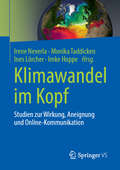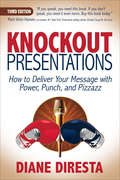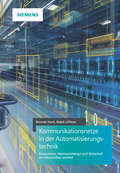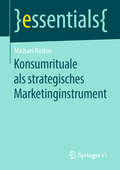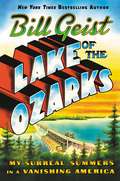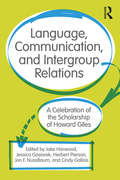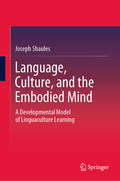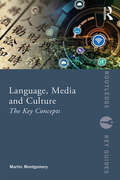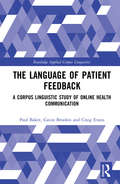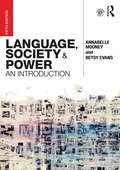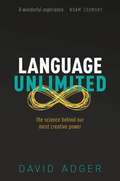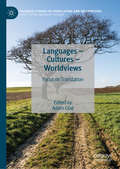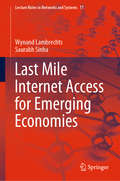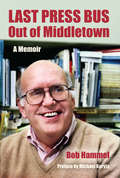- Table View
- List View
Jimmy Neurosis: A Memoir
by James OselandA Lambda Literary Award FinalistFrom a celebrated figure of the food world comes a poignant, provocative memoir about being young and gay during the 1970s punk revolution in AmericaLong before James Oseland was a judge on Top Chef Masters, he was a teenage rebel growing up in the pre–Silicon Valley, California, suburbs, yearning for a taste of something wild. Diving headfirst into the churning mayhem of the punk movement, he renamed himself Jimmy Neurosis and embarked on a journey into a vibrant underground world populated by visionary musicians and artists. In a quest that led him from the mosh pits of San Francisco to the pop world of Andy Warhol’s Manhattan, he learned firsthand about friendship of all stripes, and what comes of testing the limits—both the joyous glories and the unanticipated, dangerous consequences. With humor and verve, Oseland brings to life the effervescent cocktail of music, art, drugs, and sexual adventure that characterized the end of the seventies. Through his account of how discovering his own creativity saved his life, he tells a thrilling and uniquely American coming-of-age story.
The Job-Ready Guide: How to Set Yourself Up for Career Success
by Anastasia de WaalTo get the career you want, you need to be job-ready. This is your all-in-one guide to understanding what employers want and how to prepare yourself with a personal career plan. From gaining work experience, to mastering essential skills and acing the application process, The Job-Ready Guide is a complete resource for standing out from the crowd and getting a job offer. It shows you how to build a strong CV, write an impressive cover letter, excel at interviews, and cultivate the professionalism that employers want.Moving from education into the workplace can be a challenge: the world of work demands skills that you may never have had to truly use - or think about - before. The Job-Ready Guide will help you to boost your employability, covering everything you need to prepare for and start a successful career. You'll be able to conduct a systematic job search, learn how to network and develop a personal brand online, as well as hone valuable skills including leadership, teamwork, creativity and problem-solving. A highly practical, hands-on guide, this book is packed with useful features, including interactive exercises to help you in your real life; insider advice from employers; and tips from professionals at different stages in their careers who reveal 'what they wish they'd known'.
Journalism in the Age of Virtual Reality: How Experiential Media Are Transforming News
by John PavlikWith the advent of the internet and handheld or wearable media systems that plunge the user into 360º video, augmented—or virtual reality—technology is changing how stories are told and created. In this book, John V. Pavlik argues that a new form of mediated communication has emerged: experiential news. Experiential media delivers not just news stories but also news experiences, in which the consumer engages news as a participant or virtual eyewitness in immersive, multisensory, and interactive narratives.Pavlik describes and analyzes new tools and approaches that allow journalists to tell stories that go beyond text and image. He delves into developing forms such as virtual reality, haptic technologies, interactive documentaries, and drone media, presenting the principles of how to design and frame a story using these techniques. Pavlik warns that although experiential news can heighten user engagement and increase understanding, it may also fuel the transformation of fake news into artificial realities, and he discusses the standards of ethics and accuracy needed to build public trust in journalism in the age of virtual reality. Journalism in the Age of Virtual Reality offers important lessons for practitioners seeking to produce quality experiential news and those interested in the ethical considerations that experiential media raise for journalism and the public.
Journalism, Politics, and the Dakota Access Pipeline: Standing Rock and the Framing of Injustice (Routledge Studies in Environmental Communication and Media)
by Ellen MooreThis book explores tensions surrounding news media coverage of Indigenous environmental justice issues, identifying them as a fruitful lens through which to examine the political economy of journalism, American history, human rights, and contemporary U.S. politics. The book begins by evaluating contemporary American journalism through the lens of "deep media", focusing especially on the relationship between the drive for profit, professional journalism, and coverage of environmental justice issues. It then presents the results of a framing analysis of the Standing Rock movement (#NODAPL) coverage by news outlets in the USA and Canada. These findings are complemented by interviews with the Standing Rock Sioux Tribe, whose members provided their perspectives on the media and the pipeline. The discussion expands by considering the findings in light of current U.S. politics, including a Trump presidency that employs "law and order" rhetoric regarding people of color and that often subjects environmental issues to an economic "cost-benefit" analysis. The book concludes by considering the role of social media in the era of "Big Oil" and growing Indigenous resistance and power. Examining the complex interplay between social media, traditional journalism, and environmental justice issues, Journalism, Politics, and the Dakota Access Pipeline: Standing Rock and the Framing of Injustice will be of great interest to students and scholars of environmental communication, critical political economy, and journalism studies more broadly.
Journalismus in Deutschland, Österreich und der Schweiz (Studies in International, Transnational and Global Communications)
by Thomas Hanitzsch Josef Seethaler Vinzenz WyssDer Band liefert eine Zustandsbeschreibung des Journalismus in einer Zeit, in der Medieninstitutionen ökonomisch unter Druck stehen und journalistische Autoritäten zunehmend hinterfragt werden. Das Buch berichtet Ergebnisse einer Befragung von über 2500 Journalist*innen in Deutschland, Österreich und der Schweiz. Im Zentrum stehen die soziodemografischen Profile der Journalist*innen, die Anstellungsverhältnisse und Tätigkeitsbereiche, ihre beruflichen Rollenverständnisse und ethischen Orientierungen, ihr Vertrauen in gesellschaftliche Institutionen sowie die Wahrnehmung von redaktioneller Autonomie und Einflüssen auf ihre Arbeit.
The Journalist of Castro Street: The Life of Randy Shilts
by Andrew E StonerAs the acclaimed author of And the Band Played On, Randy Shilts became the country's most recognized voice on the HIV/AIDS epidemic. His success emerged from a relentless work ethic and strong belief in the power of journalism to help mainstream society understand not just the rising tide of HIV/AIDS but gay culture and liberation.In-depth and dramatic, Andrew E. Stoner's biography follows the remarkable life of the brash, pioneering journalist. Shilts's reporting on AIDS in San Francisco broke barriers even as other gay writers and activists ridiculed his overtures to the mainstream and labeled him a traitor to the movement, charges the combative Shilts forcefully answered. Behind the scenes, Shilts overcame career-threatening struggles with alcohol and substance abuse to achieve the notoriety he had always sought, while the HIV infection he had purposely kept hidden began to take his life.Filled with new insights and fascinating detail, The Journalist of Castro Street reveals the historic work and passionate humanity of the legendary investigative reporter and author.
Journalistische Praxis: Automatisierte Kommunikation im Journalismus und in der Public Relation (essentials)
by Markus Kaiser Aline-Florence Buttkereit Johanna HagenauerChatbots werden im Journalismus und in der Unternehmenskommunikation immer häufiger eingesetzt, um mit den Lesern bzw. Kunden auf der Website, in Apps oder in Social-Media-Kanälen zu kommunizieren. In diesem essential wird aufgezeigt, wann sich der Einsatz von Chatbots in der digitalen Kommunikation eignet und wie Chatbots konzipiert und entwickelt werden. Und worauf zu achten ist, dass die Leser bzw. Kunden Chatbots statt menschlicher Mitarbeiter akzeptieren und sich nicht frustriert abwenden. Außerdem wird ein Ausblick gegeben, wie sich Chatbots durch Machine Learning bzw. Künstliche Intelligenz weiterentwickeln könnten.
Journalists between Hitler and Adenauer: From Inner Emigration to the Moral Reconstruction of West Germany
by Volker R. BerghahnThe moral and political role of German journalists before, during, and after the Nazi dictatorshipJournalists between Hitler and Adenauer takes an in-depth look at German journalism from the late Weimar period through the postwar decades. Illuminating the roles played by journalists in the media metropolis of Hamburg, Volker Berghahn focuses on the lives and work of three remarkable individuals: Marion Countess Dönhoff, distinguished editor of Die Zeit; Paul Sethe, “the grand old man of West German journalism”; and Hans Zehrer, editor in chief of Die Welt.All born before 1914, Dönhoff, Sethe, and Zehrer witnessed the Weimar Republic’s end and opposed Hitler. When the latter seized power in 1933, they were, like their fellow Germans, confronted with the difficult choice of entering exile, becoming part of the active resistance, or joining the Nazi Party. Instead, they followed a fourth path—“inner emigration”—psychologically distancing themselves from the regime, their writing falling into a gray zone between grudging collaboration and active resistance. During the war, Dönhoff and Sethe had links to the 1944 conspiracy to kill Hitler, while Zehrer remained out of sight on a North Sea island. In the decades after 1945, all three became major figures in the West German media. Berghahn considers how these journalists and those who chose inner emigration interpreted Germany’s horrific past and how they helped to morally and politically shape the reconstruction of the country.With fresh archival materials, Journalists between Hitler and Adenauer sheds essential light on the influential position of the German media in the mid-twentieth century and raises questions about modern journalism that remain topical today.
The Journalist's Guide to Media Law: A handbook for communicators in a digital world
by Mark Polden Mark PearsonWe are all journalists and publishers now: at the touch of a button we can send our words, sounds and images out to the world. No matter whether you're a traditional journalist, a blogger, a public relations practitioner or a social media editor, everything you publish or broadcast is subject to the law. But which law?This widely used practical guide to communication law is essential reading for anyone who writes or broadcasts professionally, whether in journalism or strategic communication. It offers a mindful approach to assessing media law risks so practitioners can navigate legal and ethical barriers to publishing in mainstream and social media.This sixth edition has been substantially revised to reflect recent developments in litigation, and the impact of national security laws and the rising gig economy where graduates might work in the news media, PR, new media start-ups, or as freelancers. It covers defamation, contempt, confidentiality, privacy, trespass, intellectual property, and ethical regulation, as well as the special challenges of commenting on criminal allegations and trials. Recent cases and examples from social media, journalism and public relations are used to illustrate key points and new developments. Whether you work in a news room, in public relations or marketing, or blog from home, make sure you have The Journalist's Guide to Media Law at your side.'Whether you're an MSM editor or reporter, a blogger, a tweeter or a personal brand, this book might save your bacon.' - Jonathan Holmes, former ABC Media Watch host'The leading text book from which most journos learned their law' - Margaret Simons, associate professor in journalism, Monash University
Key Issues in the Teaching of Spanish Pronunciation: From Description to Pedagogy (Routledge Advances in Spanish Language Teaching)
by Rajiv RaoKey Issues in the Teaching of Spanish Pronunciation: From Description to Pedagogy is a resource that encourages Spanish teachers and curriculum designers to increase their incorporation of pronunciation into the classroom. Combining theory and practical guidance, it will help language practitioners integrate the teaching of Spanish pronunciation with confidence and effectiveness. The international group of scholars across its 15 chapters is made up of individuals with well-established research records and training in best pedagogical practices. Key features: A range of topics including vowels, various classes of consonants, prosody, the use of technology, the role of orthography, the importance of both perception and production, individual learner differences, and teacher training; Overviews of descriptive, empirical, and acquisition-based research associated with each aspect of the Spanish sound system; Guidance on the difficulties that teachers face when incorporating the teaching of pronunciation into the classroom; Clear explanations of concepts, accompanied by an abundance of concrete examples and references; Multiple sample activities and lesson plans tailored to different levels and backgrounds of students; A bilingual glossary of terms to help the content reach the widest audience possible. Written in a clear and accessible manner, Key Issues in the Teaching of Spanish Pronunciation is an essential resource for teachers of Spanish at all levels. It is also an excellent reference book for researchers and both undergraduate and graduate university students interested in Spanish phonetics and language acquisition.
Klimawandel im Kopf: Studien zur Wirkung, Aneignung und Online-Kommunikation
by Irene Neverla Monika Taddicken Ines Lörcher Imke HoppeKlimawandel ist ein Meta-Thema - seit Jahrzehnten auf der Agenda der Medien, global diskutiert, mit vielen Anschlusspunkten in politische, wirtschaftliche, kulturelle Fragen und Alltagsbelange. Was aber findet sich in den Köpfen der Menschen zum Thema Klimawandel? Welche Kommunikationskanäle, welche journalistischen und welche Online-Angebote waren dafür wichtig, und wie hängen Wissen, Einstellungen und Verhaltensbereitschaften damit zusammen? Die mit verschiedenen Methoden erarbeiteten Ergebnisse in diesem Buch zeigen, wie ,eigensinnig' bzw. kreativ sich Menschen das Thema Klimawandel aneignen, wie vielfach vernetzt und ,rhizomartig' die klimabezogene Kommunikation verläuft.
Knockout Presentations: How to Deliver Your Message with Power, Punch, and Pizzazz
by Diane DiRestaCalled the Bible of Public speaking, Knockout Presentations is a &“seminar in a book&” that reduces fear and gives speakers the steps to craft and deliver a talk that will make them a knockout on the platform! It&’s the next best thing to having Diane DiResta there to teach in person. DiResta provides all the fundamentals without the fluff. Speakers learn what confidence looks like, sounds like, and how to speak the language of confidence, reduce preparation time, craft a compelling talk, size up an audience, overcome fear, and master questions and answers. The Dos and Don&’ts at the end of each chapter help speakers review and remember the principles even after putting them into practice. Speaking is the new competitive advantage and Knockout Presentations gives speakers tools and techniques, templates, and resources to improve their skills.
Kommunikationsnetze in der Automatisierungstechnik: Bussysteme, Netzwerkdesign und Sicherheit im industriellen Umfeld
by Ricarda Koch Ralph LüftnerDas Buch vermittelt die Grundlagen für den Einsatz von Industrial Ethernet und Kommunikationsbussen in der Industrieautomatisierung. Es beginnt mit einer Einführung in verschiedene Feldbussysteme, in Ethernet mit seinen unterschiedlichen Ausprägungen sowie den Aufbau und die Protokollarchitektur von TCP/IP. Es folgen Abschnitte zu Wireless-Netzwerken und zu Protokollen zur Steigerung der Netzwerkverfügbarkeit sowie eine grundlegende Einführung in PROFINET. Praxisbeispiele zeigen die Konfiguration von PROFINET-IO-Netzwerken, MRP-Ringen, Shared Devices und I-Devices mit STEP 7 V5.6 und TIA Portal V15. Im Kapitel zu Industrial Security erläutert das Buch Angriffstechniken und Maßnahmen, Konzepte und Architekturen zur Netzwerksicherheit. Firewall-Beispielkonfigurationen mit dem TIA Portal V15 und SCALANCE S geben eine Hilfestellung für eigene Projekte. Das folgende Kapitel zeigt, wie ein industrielles Netzwerk in der Praxis strukturiert ist und welche Komponenten man dabei nutzen kann. Ein Ausblick zu Digital Connectivity und dem industriellen Internet der Dinge (IIoT) rundet das Buch ab. Inhalt Einführung in Kommunikationsnetze: PROFIBUS, AS-Interface, CAN-Bus, Ethernet, TCP/IP, WLAN, Netzwerkverfügbarkeit PROFINET: Funktionsprinzip, Real-Time-Konzept, Konfiguration, MRP, Shared Device, I-Device, Beispielkonfigurationen mit STEP 7 und TIA Portal Industrial Security: Angriffstechniken und Täterprofile, Anlagensicherheit, Netzwerksicherheit, Systemintegrität, Security-Beispielkonfigurationen mit dem TIA Portal V15 und SCALANCE Komponenten und Netzwerke:SCALANCE, Aufbau und Struktur industrieller Netzwerke Ausblick: Auf dem Weg zur Digital Connectivity
Konsumrituale als strategisches Marketinginstrument (essentials)
by Michael RoslonKonsumrituale stellen ein randständiges Forschungsgebiet der (Konsum-)Soziologie dar, was insofern erstaunlich ist, als dass die Ritualforschung eine etablierte Größe in den Sozial- und Kommunikationswissenschaften darstellt. Aus diesem Grund zielt Michael Roslon mit diesem essential darauf ab, die Erkenntnisse der Ritualforschung auf die Analyse von Konsumhandlungen zu übertragen. Auf diese Weise können Unternehmen wichtige Consumer Insights generieren, die sie im Rahmen ihrer Kommunikationsanstrengungen gewinnbringend anwenden können.
Kurukshetra May 2019
by Publication DivisionThis is a monthly magazine of Kurukshetra May 2019 of this year.
Lake of the Ozarks: My Surreal Summers in a Vanishing America
by Bill GeistBefore there was "tourism" and souvenir ashtrays became "kitsch," the Lake of the Ozarks was a Shangri-La for middle-class Midwestern families on vacation, complete with man-made beaches, Hillbilly Mini Golf, and feathered rubber tomahawks. <P><P> It was there that author Bill Geist spent summers in the Sixties during his school and college years working at Arrowhead Lodge-a small resort owned by his bombastic uncle-in all areas of the operation, from cesspool attendant to bellhop. What may have seemed just a summer job became, upon reflection, a transformative era where a cast of eccentric, small-town characters and experiences shaped (some might suggest "slightly twisted") Bill into the man he is today. <P><P>He realized it was this time in his life that had a direct influence on his sensibilities, his humor, his writing, and ultimately a career searching the world for other such untamed creatures for the Chicago Tribune, the New York Times, and CBS News. <P><P>In LAKE OF THE OZARKS, Emmy Award-winning CBS Sunday Morning Correspondent Bill Geist reflects on his coming of age in the American Heartland and traces his evolution as a man and a writer. He shares laugh-out-loud anecdotes and tongue-in-cheek observations guaranteed to evoke a strong sense of nostalgia for "the good ol' days." <P><P>Written with Geistian wit and warmth, LAKE OF THE OZARKS takes readers back to a bygone era, and demonstrates how you can find inspiration in the most unexpected places. <P><b>A New York Times Bestseller</b>
Language, Communication, and Intergroup Relations: A Celebration of the Scholarship of Howard Giles
by Jake Harwood Jessica Gasiorek Herbert D. Pierson Jon F. Nussbaum Cynthia GalloisLanguage, Communication, and Intergroup Relations presents the current state of knowledge at the intersection of language, communication, and intergroup relations, drawing on interdisciplinary work from the fields of communication, social psychology, and sociolinguistics. Building from that existing work, it presents a series of provocative and innovative new directions in this area. The work is organized around a series of five themes: • Language and Culture • Intergroup Communication • Intergenerational Relations • Interpersonal Accommodation • Institutional Accommodation. Within each theme, prominent scholars present reviews of the literature, which are followed by responses, reactions, and extensions from a multidisciplinary group of researchers. These responses often move beyond typical academic prose and engage with the material in novel ways, including graphical theoretical models, short personal reflections, and creative prose. It is essential reading for students and academics in the interdisciplinary fields of communication, language, and social psychology.
Language, Culture, and the Embodied Mind: A Developmental Model of Linguaculture Learning
by Joseph ShaulesThere is an odd contradiction at the heart of language and culture learning: Language and culture are, so to speak, two sides of a single coin—language reflects the thinking, values and worldview of its speakers. Despite this, there is a persistent split between language and culture in the classroom. Foreign language pedagogy is often conceptualized in terms of gaining knowledge and practicing skills, while cultural learning goals are often conceptualized in abstract terms, such as awareness or criticality.This book helps resolve this dilemma. Informed by brain and mind sciences, its core message is that language and culture learning can both be seen as a single, interrelated process—the embodiment of dynamic systems of meaning into the intuitive mind. This deep learning process is detailed in the form of the Developmental Model of Linguaculture Learning (DMLL). Grounded in dynamic skill theory, the DMLL describes four developmental levels of language and culture learning, which represents a subtle, yet important shift in language and culture pedagogy. Rather than asking how to add culture into language education, we should be seeking ways to make language and culture learning deeper—more integrated, embodied, experiential and transformational. This book provides a theoretical approach, including practical examples, for doing so.
Language, Media and Culture: The Key Concepts (Routledge Key Guides)
by Martin MontgomeryLanguage, Media and Culture: The Key Concepts is an authoritative and indispensable guide to the essential terminology of the overlapping fields of Language, Media and Culture. Designed to give students and researchers ‘tools for thinking with’ in addressing major issues of communicative change in the 21st century, the book covers over 500 concepts as well as containing an extensive bibliography to aid further study. Subjects covered include: Authenticity Truthiness Structures of feeling Turn-taking Transitivity Validity claims With cross referencing and further reading provided throughout, this book provides an inclusive map of the discipline, and is an essential reference work for students in communication, media, journalism and cultural studies, as well as for students of language and linguistics.
The Language of Patient Feedback: A Corpus Linguistic Study of Online Health Communication (Routledge Applied Corpus Linguistics)
by Paul Baker Gavin Brookes Craig EvansThe Language of Patient Feedback provides a unique insight into a diverse range of issues related to healthcare. Through the comprehensive and detailed interrogation of 29 million words of online patient feedback on the NHS in England, as well as 11 million words of responses to the feedback from NHS providers, this book: Uses a combination of computer-assisted and human analysis (Corpus-Assisted Discourse Analysis) to examine the extent to which characteristics like age and gender result in different types of evaluation. Investigates why nurses, doctors, dentists and receptionists are associated with very distinct types of feedback. Demonstrates the ways that NHS staff respond to comments and what this reveals about underlying institutional ideologies and practices. Concludes with suggestions for key recommendations that the NHS could act upon to improve the overall level of care it provides, as well as reflecting on what patient evaluation can actually tell us. The Language of Patient Feedback is key reading for anyone undertaking research within corpus linguistics, discourse analysis and health communication.
Language, Society and Power: An Introduction
by Betsy Evans Annabelle MooneyLanguage, Society and Power is an accessible introduction to studying language in a variety of social contexts. This book examines the ways language functions, how it influences the way we view society and how it varies according to age, ethnicity, class and gender. It considers whether representations of people and their language matter, explores how identity is constructed and performed, and considers the creative potential of language in the media, politics and everyday talk. The fifth edition of this popular textbook features: Updated chapters with new activities; Examples that include material related to youth language, computer-mediated communication, texting and electronic communication; New material on online mass media, fake news and Twitter as a form of political agency; More discussion of social media, social networking, memes and mobile communication; An introduction to the concepts of translanguaging and superdiversity; An expanded Gender chapter that questions binary gender identities; A companion website which includes more video material to support learning as students make their way through the book. Language, Society and Power assumes no linguistic background among readers, and is a must-read for all students of English language and linguistics, media, communication, cultural studies, sociology and psychology who are studying language and society for the first time.
Language Unlimited: The Science Behind Our Most Creative Power
by David AdgerAll humans, but no other species, have the capacity to create and understand language. It provides structure to our thoughts, allowing us to plan, communicate, and create new ideas, without limit. Yet we have only finite experiences, and our languages have finite stores of words. Where does our linguistic creativity come from? How does the endless scope of language emerge from our limited selves? Drawing on research from neuroscience, psychology, and linguistics, David Adger takes the reader on a journey to the hidden structure behind all we say (or sign) and understand. Along the way you'll meet children who created language out of almost nothing, and find out how new languages emerge using structures found in languages spoken continents away. David Adger will show you how the more than 7000 languages in the world appear to obey the same deep scientific laws, how to invent a language that breaks these, and how our brains go crazy when we try to learn languages that just aren't possible. You'll discover why rats are better than we are at picking up certain language patterns, why apes are far worse at others, and how artificial intelligences, such as those behind Alexa and Siri, understand language in a very un-human way. This book explores the many mysteries about our capacity for language and reveals the source of its endless creativity.
Languages – Cultures – Worldviews: Focus on Translation (Palgrave Studies in Translating and Interpreting)
by Adam GłazThis edited book explores languages and cultures (or linguacultures) from a translation perspective, resting on the assumption that they find expression as linguacultural worldviews. Specifically, it investigates how these worldviews emerge, how they are constructed, shaped and modified in and through translation, understood both as a process and a product. The book’s content progresses from general to specific: from the notions of worldview and translation, through a consideration of how worldviews are shaped in and through language, to a discussion of worldviews in translation, both in macro-scale and in specific details of language structure and use. The contributors to the volume are linguists, linguistic anthropologists, practising translators, and/or translation studies scholars, and the book will be of interest to scholars and students in any of these fields.
Last Mile Internet Access for Emerging Economies (Lecture Notes in Networks and Systems #77)
by Wynand Lambrechts Saurabh SinhaThis book presents an investigative approach to globalization-driving technologies that efficiently deliver ubiquitous, last-mile, broadband internet access to emerging markets and rural areas. Research has shown that ubiquitous internet access boosts socio-economic growth through innovations in science and technology, and has a positive effect on the lives of individuals. Last-mile internet access in developing countries is not only intended to provide areas with stable, efficient, and cost-effective broadband capabilities, but also to encourage the use of connectivity for human capacity development. The book offers an overview of the principles of various technologies, such as light fidelity and millimeter-wave backhaul, as last-mile internet solutions and describes these potential solutions from a signal propagation perspective. It also provides readers with the notional context needed to understand their operation, benefits, and limitations, and enables them to investigate feasible and tailored solutions to ensure sustainable infrastructures that are expandable and maintainable.
Last Press Bus Out of Middletown: A Memoir
by Bob Hammel Michael KorytaFor 30 years, celebrated sports journalist Bob Hammel has reported on a variety of games and athletes–the Olympics, Pan American Games, 23 NCAA Final Fours, Major League Baseball playoffs and World Series, college football bowl games, Muhammad Ali's last championship victory, and dozens of Indiana high school basketball Final Fours. In all that time, however, he's never written much about himself–ntil now. In Last Press Bus Out of Middletown, Bob tells the story of how an Indiana sports journalist without a college degree, armed with talent, gumption, and a whole lot of inspiration and advice from those he worked with, earned national attention while still working for his small-town newspaper. From Bob Knight to Mark Spitz, from the horrors of the Munich Olympics tragedy to the Hoosiers' exhilarating clinching of the NCAA basketball championship, Bob Hammel's journey has been unforgettable. Even in his 80s, it's a dream that still has him smiling and storytelling.
